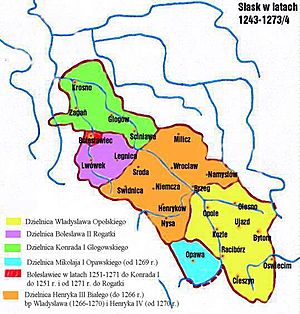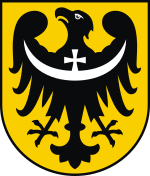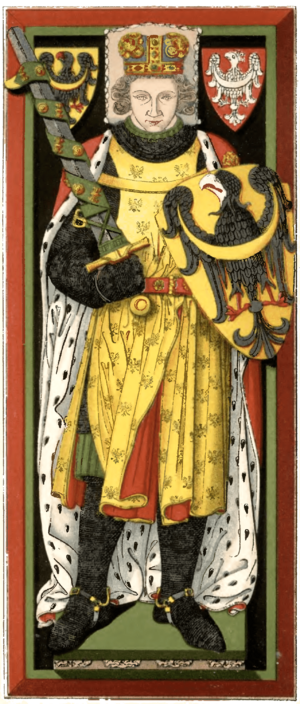Henryk IV Probus facts for kids
Quick facts for kids Henryk IV Probus |
|
|---|---|
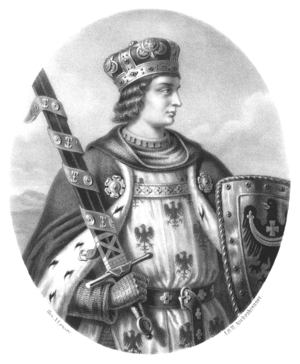 |
|
| High Duke of Poland | |
| Reign | 1288–1290 |
| Predecessor | Leszek II the Black |
| Successor | Przemysł II |
| Duke of Silesia-Wrocław | |
| Reign | 1266–1290 |
| Predecessor | Henry III the White |
| Successor | Henry V the Fat |
| Born | c. 1257/58 |
| Died | 23 June 1290 Wrocław, Kingdom of Poland |
| Spouse | Constance of Opole (−1287) Matilda of Brandenburg (1287–1290) |
| House | Silesian Piasts |
| Father | Henry III the White |
| Mother | Judith of Masovia |
| Religion | Roman Catholic |
Henryk IV Probus (born around 1258 – died 23 June 1290) was an important ruler from the Piast dynasty in Poland. His nickname, Probus, means "the Righteous" in Latin. He was a member of the Silesian Piasts, a branch of the royal Polish family.
Henryk was the Duke of Silesia in Wrocław starting in 1266. Later, in 1288, he also became the High Duke of Poland, ruling the important region of Kraków. He held these titles until his death in 1290.
Contents
Early Life and Education
Henryk IV was the only son of Duke Henry III the White of Silesia-Wrocław. His mother was Judith of Masovia.
Growing Up with Guardians
Henryk's father died early in 1266, when Henryk was still a child. He was placed under the care of his uncle, Archbishop Władysław of Salzburg. The Archbishop thought that traveling between Wrocław and Salzburg was not good for a child. So, in 1267, Henryk was sent to Prague. He grew up at the court of King Ottokar II of Bohemia. After his uncle Władysław died in 1270, King Ottokar II also took over the care of Wrocław.
Soon after his uncle's death, Henryk IV returned to Wrocław. There, he was looked after by Simon Gallicusa, a close advisor to his late father. Henryk received a very good education. This might be why he became so interested in culture and poetry later on. Some people even think he wrote poems in old Polish! Henryk IV and King Ottokar II worked very well together. In 1271, Henryk IV joined a military trip against Hungary. This led to an attack on Wrocław by Hungarian princes and their allies from Greater and Lesser Poland.
In 1273, Henryk IV officially became an adult. He took control of his Duchy of Wrocław. However, his duchy was smaller now, only covering the eastern part of Lower Silesia. This was because other parts had split off into separate duchies like Opole, Legnica, and Głogów. Henryk started to make his own decisions, becoming more independent from Bohemia. He also made friends with his cousin Duke Władysław of Opole from Upper Silesia and Duke Przemysł II of Greater Poland.
Challenges and Conflicts
Henryk IV faced many challenges during his rule, including being kidnapped and fighting for power.
Kidnapped by Bolesław II the Bald
In 1276, Henryk supported King Ottokar II in a big fight against King Rudolf I of Germany. Henryk helped the Bohemian troops by giving them food and shelter. But when Ottokar was punished by the Holy Roman Empire, Duke Bolesław II the Bald of Legnica saw his chance. In 1277, he captured his nephew Henryk at Jelcz and put him in prison.
People were very angry about Henryk IV's imprisonment. Ottokar's Polish allies, Duke Henry III of Głogów and Duke Przemysł II of Greater Poland, tried to free Henryk. However, King Ottokar only sent messages asking for his release. Henryk IV's allies were defeated by Duke Bolesław II's son, Henry V the Fat. This happened in the bloody Battle of Stolec on April 24, 1277. Both Dukes Przemysł II and Henry III were captured in this battle.
Henryk IV finally got his freedom at the end of the year. He had to give in after hearing that his main ally, King Ottokar II, was defeated. This happened in the 1278 Battle on the Marchfeld against the Imperial and Hungarian armies. Henryk IV was forced to give Bolesław II one-third of his duchy. This included the towns of Środa Śląska and Strzegom. He also had to promise Krosno Odrzańskie, which he had gained earlier, to get money for his release.
After Ottokar II's Death
Henryk himself did not fight in the Battle on the Marchfeld. But he had sent help to King Ottokar II. So, Ottokar's death was a big blow to Henryk. After hearing the news, Henryk IV went to Prague. He tried to become the guardian of the king's son, Wenceslaus II of Bohemia. Henryk was one of Wenceslaus's closest relatives, as Henryk's grandmother was Anna of Bohemia, daughter of King Ottokar I of Bohemia.
However, Henryk was not successful. King Rudolph I of Germany gave the guardianship of Bohemia to Margrave Otto V, Margrave of Brandenburg-Salzwedel of Brandenburg. As a reward, the German king gave Henryk IV the Bohemian County of Kladsko as a fief, which was a piece of land held in exchange for loyalty.
Meeting with King Rudolph I
After his Bohemian ally died, Henryk IV made peace with King Rudolph I. In 1280, Henryk went to Rudolph's court in Vienna. There, Henryk tried to get the Polish royal crown for himself.
Some historians believe that Henryk used this meeting to suggest to King Rudolph I that he could become the King of Poland. At that time, he also made an agreement with Duke Władysław of Opole. Władysław promised to help Henryk IV. In return, Władysław's daughter (who was married to Henryk IV) would be crowned as Polish queen if Henryk became king.
Seeking Power in Silesia and Poland
Henryk IV's relationships with his Silesian relatives were generally not good. In 1280, Duke Henry V the Fat of Legnica, supported by Brandenburg, invaded Henryk's lands again. Henryk managed to resist, but it was difficult.
To improve the situation, Henryk IV organized a meeting in Sądowel in February 1281. This village was in his Duchy of Wrocław. The goal was to find ways for the Silesian dukes to work together. However, Henryk IV had other plans. He quickly captured his old enemy, Duke Henry V the Fat of Legnica. He also captured his own allies, Dukes Henry III of Głogów and Przemysł II of Greater Poland. He did this to force them to agree to his political demands.
Przemysł II was forced to give Henryk the important land of Wieluń (also called Ruda) in Lesser Poland. He also had to accept Henryk IV as his overlord and pay homage to him. In the years that followed, Henryk IV's smart policies led to other Silesian dukes, like Przemko of Ścinawa and Bolko I of Opole, willingly accepting his authority. It seemed like Silesia might become united under his rule.
However, not all Silesian dukes accepted his power. Dukes Bolko I the Strict, Konrad II the Hunchback, and three of Władysław of Opole's four sons were against Henryk's policies. These sons were Casimir of Bytom, Mieszko I of Cieszyn, and Przemysław of Racibórz. The situation with the Opole Dukes became more complicated. In 1287, Henryk IV had his marriage to their sister annulled. She was sent back home. The fourth son of Władysław, Bolko I, remained loyal to Henryk IV.
Henryk IV first tried to take the Seniorate Province at Kraków in 1280–1281. This was in response to an invasion by the Polish High Duke Leszek II the Black against Wrocław. However, this attempt was not successful.
Conflict with Bishop Thomas II
From 1282 to 1287, Henryk IV was involved in a long fight with the Bishop of Wrocław, Tomas II Zaremba. The first part of this conflict happened between 1274 and 1276. It ended with a decision that didn't satisfy either side. The disputes started again in 1282. This time, the fight was over lands and properties taken by the church after the Battle of Legnica. It was also about whether church leaders could be tried in regular courts.
In early 1282, the Bishop complained to the Papal Legate Philip of Ferno. The Legate was supposed to settle the dispute. His decision favored the Church, but Henryk IV disagreed. In 1283, Henryk IV organized a large meeting of bishops in Nysa. The main event was a knight's tournament. However, the problems continued. Bishop Thomas II, with the Papal Legate's support, wanted to make Henryk IV obey. So, in March 1284, he excommunicated Henryk IV and the entire Duchy. This meant they were cut off from the Church. But the Duke of Wrocław refused to give in. In the same year, he asked Pope Martin IV for help. It soon became clear that he couldn't expect a positive answer from Rome. Even though Thomas II tried to make all local clergy obey him, some religious groups, like the Franciscans, stayed loyal to Henryk IV. The conflict continued, even after the Archbishop of Gniezno, Jakub Świnka, tried to make peace.
In 1285, Henryk IV used his power over the clergy. He took some lands that belonged to the bishopric Duchy of Nysa–Otmuchów. Bishop Thomas II was forced to leave and go to the Duchy of Racibórz. The final part of the dispute happened in 1287 when Henryk IV entered Racibórz. Thomas II could no longer escape and finally agreed to obey the Duke of Wrocław. But Henryk IV was kind in his victory. He gave back the rich lands he had taken from the Bishopric. He also founded a church called a Kolegiata, dedicated to the Holy Cross.
In his foreign policy, Henryk IV kept trying to get other Silesian Dukes to accept his authority. This could indirectly help him become King. In 1284, he used the betrayal of the Zaremba noble family (Bishop Thomas II's family) as an excuse to capture the town of Kalisz. The Dukes of Greater Poland never accepted this loss. So, after some talks, Kalisz was exchanged for the town of Ołobok with Duke Przemysł II.
Becoming High Duke of Poland
On September 30, 1288, Leszek II the Black, who was the Duke of Sieradz and High Duke of Poland, died without children. This gave Henryk IV a chance to achieve his big goal: to gain Kraków and the title of High Duke. To do this, he started looking for allies in 1287. He made peace with Przemysł II and gave him back Wieluń. Some historians believe that Leszek II the Black, Henryk IV, Przemysł II, and Henry III of Głogów had planned to unite Poland. Whether this is true or not, Henryk IV was ready to act when he heard of Leszek II's death.
Henryk IV's main rivals for the Kraków throne were Leszek II's half-brother Władysław I the Elbow-high and Duke Bolesław II of Płock. These dukes had the support of the Lesser Poland nobility. However, the Duke of Płock failed to get the strong support of Castellan Sulk the Bear, who was the city's governor. On February 26, 1289, a bloody Battle of Siewierz took place. It was fought between the troops of the Dukes of Płock and Kuyavia against Henryk IV's troops. Henryk's forces were supported by King Rudolph I and the Dukes of Opole, Głogów, and Ścinawa. The Masovia-Kuyavia side won the battle. Two of Henryk IV's allies suffered greatly: Duke Przemko of Ścinawa was killed, and Duke Bolko I of Opole was badly hurt and captured by Władysław I the Elbow-high.
Despite this success, Duke Bolesław II of Płock surprisingly gave up his claim to the throne. He left the Kraków inheritance to Władysław I the Elbow-high. As the war turned in his favor, Władysław I, with help from the Bishop of Kraków, Paul of Półkozic, managed to surround and capture Wawel castle. He forced Henryk's Silesian troops to retreat.
However, Henryk IV gathered his forces again. In August 1289, he marched against Kraków himself, leading his army. Thanks to some people in Kraków who helped him, and with the help of the Franciscans (who even hid him in their monastery), Henryk IV took the city. He was then recognized as the High Duke. Despite his victory, Henryk IV decided to stay in Sandomierz.
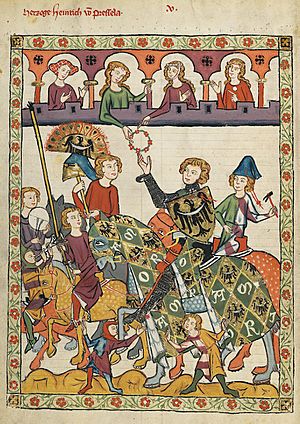
Henryk IV's Rule
During his time as ruler, Henryk made the central government stronger in his duchy. He also helped improve the economy. He supported mining and the growth of cities. Many cities received German city law and special rights. Henryk was also a very educated man. He spoke several languages fluently and actively supported Western court culture and the ideals of chivalry. Henryk himself was a talented poet. Two of his poems were written down in the Codex Manesse, a famous collection of medieval songs.
Death of Henryk IV
Henryk IV died suddenly in 1290, when he was no more than thirty-two years old. The details of his death, written by the chronicler Ottokar of Styria, are seen by some historians as very reliable, while others doubt them.
The year of his death is widely accepted and confirmed by many sources. However, the exact day is given differently by various sources. The most supported date, given by the Church of St. John the Baptist, is June 23. Other suggested dates include June 24, July 22, and even April.
Mystery of His Death
Several independent sources talk about the cause of Henryk IV's death. These include records from the tombs of Silesian Dukes, the Chronicle of Jan Długosz, and later chronicles like the Bohemian Chronicle of Pulkawy and the Chronicle of Ottokar of Styria.
According to Ottokar of Styria, Henryk IV wanted to become King of Poland. He asked the Pope for permission to be crowned. The talks were going well, and he sent 12,000 grzywnas (a type of currency) as a gift to the Pope. But when the messenger reached Italy, it was found that 400 grzywnas had been stolen during the trip. The Pope was very angry and stopped all talks with Henryk IV. The person who stole the money managed to escape. Henryk IV wanted to punish him. To prevent Henryk's revenge, someone decided to get rid of him. A false lawyer (who was the brother of one of the Duke's doctors) was hired at the court of Wrocław. This person slowly poisoned Henryk IV. Another doctor, named Guncelin, recognized the signs of poisoning. He was able to save the Duke from immediate death by making him vomit. But the assassin was not found. This time, the poison was put on the knife Henryk IV used to cut his bread. The poison was finally detected, but it was too late to save the Duke. Henryk IV died in the Catholic faith. He decided not to try and punish those who had poisoned him.
This is a very detailed story about the Duke's death. Only some parts of it are confirmed by other sources. Other stories say that a chaplain named Aleksy, acting for King Wenceslaus II of Bohemia, betrayed Henryk IV's interests. He tried to give the crown to Przemysł II. In these stories, the theft of money sent to Rome is also mentioned. But the ending is a little different: the thief was killed by his own servants in the streets of Rome.
Henryk IV's Will
According to chroniclers, the dying Henryk IV made two important documents. One was for the Wrocław church. It gave the Bishop permission to have full control over the Duchy of Nysa–Otmuchów. The other document was political. It decided who would inherit his lands. In this will, he left the Duchy of Wrocław to Duke Henry III of Głogów. He left Kraków and the title of High Duke to Przemysł II. If one of these princes died, the other could take control of their lands. Many historians believe there might have been a third document. If true, this would have been a step towards reuniting Poland. Henryk IV, who was sometimes criticized in older writings, might have truly wanted what was best for Poland.
Only the will for the Church was fully carried out. Henryk IV was buried in the Kolegiata of the Holy Cross and St. Bartholomeus in Wrocław, a church he had founded.
Henry V the Fat was able to take Wrocław with the help of King Wenceslaus II of Bohemia. This happened after the local nobles refused to accept Henry III of Głogów as their ruler. Wenceslaus II himself gained the Seniorate Province, but Duke Przemysł II kept the title of High Duke.
During World War II, German anthropologists wanted to study Henryk IV's remains. They wanted to prove a certain "Germanic look." His remains were removed for testing but were unfortunately lost during the war. His sarcophagus is now in the National Museum in Wrocław.
Marriages
Around March 1280, Henryk IV first married the daughter of Duke Władysław of Opole. Her name might have been Constance. They were married for almost seven years but had no children. The Duke of Wrocław had their marriage ended, saying she couldn't have children. However, modern historians question this reason.
By 1288, Henryk IV married a second time to Matilda. She was the daughter of Margrave Otto V "the Tall" of Brandenburg–Salzwedel. Historian Ewa Maleczyńska suggested that the real reason Henryk IV divorced his first wife was because he was having a relationship with Matilda and wanted to marry her. Henryk and Matilda also had no children.
See also
 In Spanish: Enrique IV de Breslavia para niños
In Spanish: Enrique IV de Breslavia para niños
- History of Poland (966–1385)
- History of Silesia
- Piast dynasty
- Dukes of Silesia


